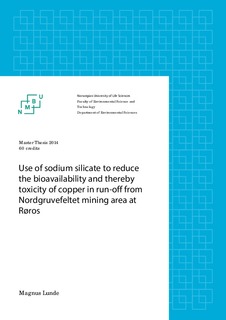| dc.description.abstract | Metal run-off from derelict mining sites poses serious environmental concerns. Discharge water is usually enriched with a series of heavy metals such as aluminum (Al), cadmium (Cd), chromium (Cr), copper (Cu), iron (Fe), nickel (Ni), manganese (Mn), and zinc (Zn), which may exert toxic effects to aquatic organisms. Fish dwelling in the associated draining streams are exposed, and metal accumulation in gills may induce mortality due to ion regulation failure or suffocation
The uptake and toxicity of metals is dependent upon speciation and bioavailability. Water samples from Nordgruvefeltet in Røros were collected in order to identify metal run-off from the site into the Orva river catchment area. In situ size and charge fractionation (SCF), i.e. filtration and cation exchange chromatography, was utilized in order to characterize the speciation and bioavailability of the metals. Run-off from mine Arvedalsgruva is characterized by low pH water in combination with high concentration of metals, present mainly as low molecular mass (LMM) cationic species.
In rivers in the south of Norway increased levels of Al due to acid rain has been found to cause fish mortality episodes. As a result, researchers at NMBU in collaboration with the Norwegian Institute for Water Research (NIVA) have added sodium silicate (NaSil) to remediate the adverse effects of Al when levels were believed to cause detriment to the fish. This countermeasure has generally been found effective and successful.
To mitigate toxic metal fractions and assess the eligibility of NaSil as a suitable remediation technique for runoff mining waters, dose-response laboratory tests were carried out using sampled water prior to in situ testing with acid mine drainage (AMD) water. Fractionation of water demonstrated that the addition of NaSil formed Cu and Al colloids. Using NaOH in parallel tests at similar pH demonstrated, however, formation of Cu and Al particles i.e. species larger than colloids. Thus, results indicated that silicate formed colloids, probably due to complexing processes, with metals in the AMD. The formed Cu and Al colloids are most probably less bioavailable than the LMM species and probably more inert than Cu and Al particles formed by pH change only, that potentially can remobilize over time. | nb_NO |
